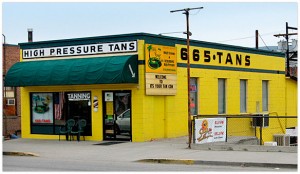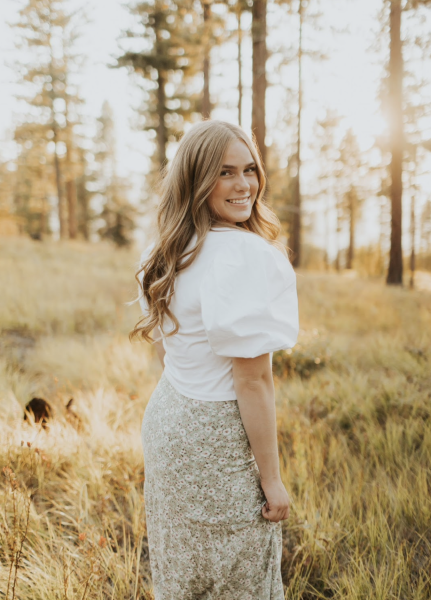Dermatologist raises concerns about artificial tanning
In today’s society, the perfectly bronze skin of models is a sought after trait. Many high schoolers tan to develop the dark skin tone that long hours in the sun or salon develop. This practice is much more dangerous than most are willing to believe.
Tanning, especially tanning beds, are literally deadly. Their regular use results in the most dangerous form of skin cancer, melanoma. According to the Centers for Disease Control and Prevention, frequent exposure to ultraviolet (UV) rays for individuals under the age of 35 increases the risk of developing melanoma by 75 percent.
Melanoma is caused by the exposure to ultraviolet light, especially the UVA rays that are concentrated in tanning beds. According to the US National Library of Medicine, cutaneous melanoma is one of the fastest growing cancers in the world.

Confluence Health Dermatologist Dr. Sharon Seguin sees skin cancer in her office every day. The type that worries her the most in young people is melanoma. She has noticed more melanoma cases recently and believes that one of the culprits is the tanning bed.
“Melanoma is a skin cancer that we can see in people, sometimes starting in their early 20’s,” Seguin said. “We think that the increase in the amount of melanoma that we’ve been seeing in the last 20-30 years is because of the increased use of tanning beds.”
Seguin emphasized the importance of awareness about melanoma. The cancer is extremely dangerous, and, if not caught in early stages, can be disastrous.
“One way is to try and decrease the risk of developing [melanoma] by having people not tan as much. The other way is to have skin exams and just having an awareness that this type of skin cancer is out there. More people know about skin cancer these days, and more people are watching new spots that are developing on their skin,” Seguin said. “The earlier you diagnose it, the more treatable it is. If we diagnose it when it’s really just staring, then we can cure it [by surgically removing it]. But if you wait too long, then it can actually lead to more problems and even death.”
A new law in Washington state recently passed that bans people under 18 years old from using a tanning salon without a doctor’s note.
“That [law] was passed by the action of a lot of dermatologists and the American Academy of Dermatology. Because we think that the worst time to [tan] is before the age of 12, but any time before the age of 18 is not [a good time] to expose yourself to those UV rays, particularly the rays of the tanning bed,” Seguin said.
When discussing tanning, there are two major types of light, UVA and UVB. These types of light are not visible to the human eye, but they result in the majority of sun damage. UVA rays penetrate skin deeper than the UVB rays. UVA rays are the dominant tanning ray, causing the majority of the color change in your skin, and thus the majority of the damage.
The tanning effect, is in fact, a sign a skin damage. Skin tans as a response to damage from UV rays. Once skin senses damage, it releases pigments that darken your skin, in an attempt to protect your skin from more damage, according to the US Food and Drug Administration.
Excessive sun exposure in general is dangerous, but tanning beds are especially lethal. UVA rays are more highly concentrated in tanning beds, to give users a faster, darker tan but also cause permanent damage to your skin.
Besides skin cancer, tanning causes wrinkles as you age. The sun permanently damages your skin and results in irreversible damage.
“[Chronic exposure to the sun] seems to break down the collagen and elastic fibers in your skin. The collagen and elastic are that tough layer of your skin. If you stretch your skin and it quickly snaps back to original shape, that means you have good collagen and elastic fibers,” Seguin said. “If you stretch an old person’s skin and it just kind of stays stretched out, that means that the collagen and elastic fibers have broken down and given out. You get saggy old looking skin, because it’s been exposed to the sun a lot, the collagen and elastic fibers have just worn out. You can’t ever change that, you can’t ever get that back, we don’t know how to reverse that damage.”
Though tanning is known to be dangerous, it is still very common. This phenomenon can partially be attributed to the large span of time before the negative aspects of tanning begin to appear. Regular tanning will not immediately result in cancer and wrinkles.
These repercussions often appear 20 to 30 years later. However, Seguin has seen people in their early 20’s with skin cancer. She emphasizes that any sun damage can cause skin cancer later on, not just tanning.
“Here in Wenatchee, we have a whole lot of people who work outside in the orchards, and a lot of those people get a lot of sun damage on their face and arms and areas like that,” Seguin said. “So later on, especially when they get to be in their 60’s or 70’s, they end up with a lot of skin cancer.”
Despite the dangers of sun damage, there are some cases in which a small amount of sun exposure can be helpful. Conditions like psoriasis and eczema can be positively affected by a limited amount of sun exposure.
“There are some conditions where we do recommend that you get some exposure, and we as dermatologists even have a light booth in our office, because there are some conditions, like psoriasis, eczema, and other conditions of the skin, where giving people low doses of artificial sunlight is helpful to clear up their skin,” Seguin said.
If you are still unconvinced of the dangers of tanning, and want to lay in the sun, or use a tanning bed, realize that you have other options for obtaining a bronze complexion. Seguin recommends artificial tans, such as spray tans or lotions.
“There are a lot of good fake tan sprays out there nowadays. I would say that would be your best bet, to use those,” Seguin said. “They don’t harm the skin; they make the skin look tan. And they won’t age your skin, they don’t increase your chance of getting wrinkled later on, or getting skin cancer.”






